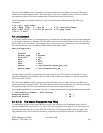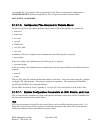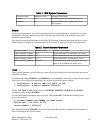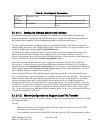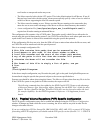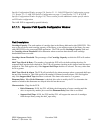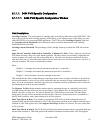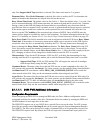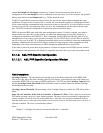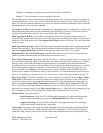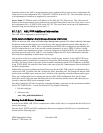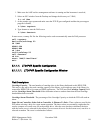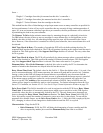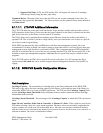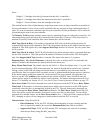only if the Support Shelf Tape checkbox is selected. The alarm value must be 2 or greater.
Dismount Delay. When Defer Dismounts is checked, this value is used by the PVL to determine the
number of minutes that dismounts are delayed after the last data access.
Retry Mount Time Limit. The default value for this field is -1. When the default value (-1) is used, if an
error is encountered during a PVR mount operation, the mount will pend and be retried every 5 minutes.
Setting a value in this field will change the mount behavior to periodically retry the mount until the
specified time limit is exceeded. Once exceeded, an error is generated and the mount request is canceled.
If the mount request would have resulted in a write operation, the error returned will cause the Core
Server to set the VV Condition of the associated tape volume to DOWN. Once in DOWN state, the
volume will no longer be available for read or write operations. For further information about the Core
Server VV Condition, see Section 4.5.4.2: Core Server Tape Volume Information Window on page 471.
Drive Error Limit. This field is intended to be used in conjunction with the PVR Server Retry Mount
Time Limit. If the number of consecutive mount errors which occur to any drive in this PVR equal or
exceed this value, the drive is automatically locked by the PVL. The only mount errors that apply are
those set through the Retry Mount Time Limit mechanism. The Drive Error Count field in the PVL
Drive Information records the number of consecutive errors on a drive by drive basis. To turn off the
automatic drive disable feature, set the Drive Error Limit to 0 or -1. Since this field is employed by the
PVL, changing its value will not change drive disable behavior until the PVL is recycled.
Characteristics. Flags for the PVR:ismounts. If ON, the PVL will delay the dismounting of a tape
cartridge until the drive is required by another job or until the Dismount Delay time limit is exceeded.
• Support Shelf Tape. If ON, the PVR and the PVL will support the removal of cartridges
from the tape library using the shelf_tape utility.
Command Device. The name of the device that the PVR can use to send commands to the robot. For
AIX systems, this is generally /dev/lmcp0. For Linux systems, use the symbolic library name defined in
/etc/ibmatl.conf. The environment variable HPSS_3494_COMMAND_DEVICE will override the
value entered in this field. Only use the environment variable when using only one 3494.
Async Device. The name of the device that the PVR can use to receive replies from the 3494 robot. For
AIX systems, this is generally /dev/lmcp1. For Linux systems, use the symbolic library name defined in
/etc/ibmatl.conf. For TTY and LAN-attached robots, the Async Device may be the same as the
Command Device. The environment variable HPSS_3494_ASYNC _DEVICE will override the value
entered in this field. Only use the environment variable when using only one 3494.
5.1.1.1.1. 3494 PVR Additional Information
Configuration Requirements
When configuring an HPSS PVR to manage an IBM robot, the Drive Address configuration entries
correspond to the device number of the drive. Determine the device number by running the HPSS tool
GetESANumbers for each tape drive in the robot.
The HPSS PVR requires one or two LMCP device special files to access the robot. For AIX systems,
these files are usually named /dev/lmcpX and can be created using the System Management Interface
Tool (SMIT). The files can be defined to be either a Command Port or an Asynchronous (Async) Port.
The HPSS PVR requires both. By default, the PVR will expect the Command and Async ports to be
HPSS Management Guide November 2009
Release 7.3 (Revision 1.0) 112




